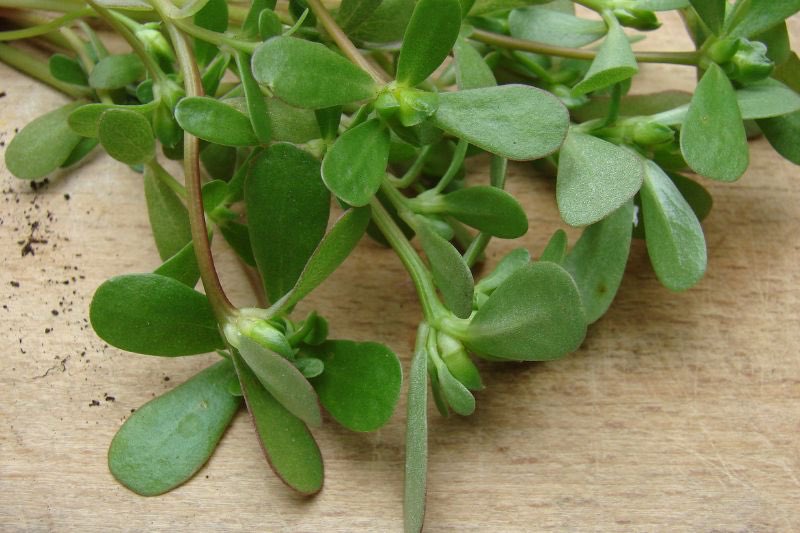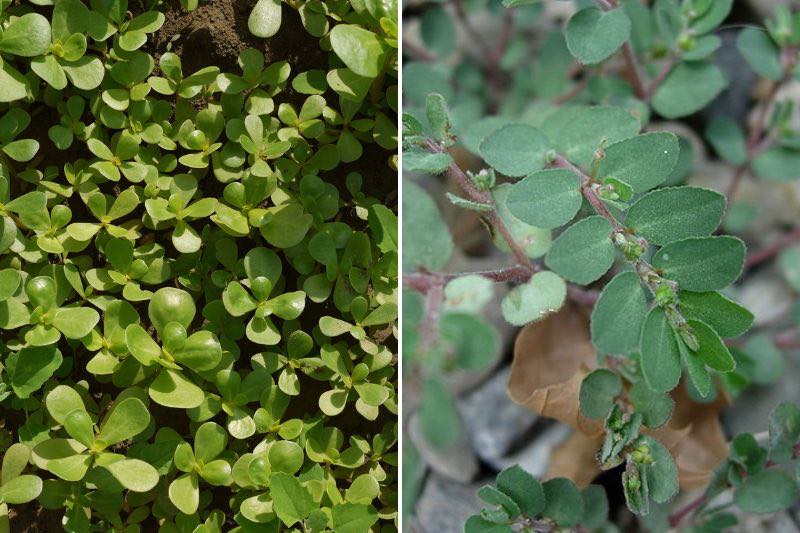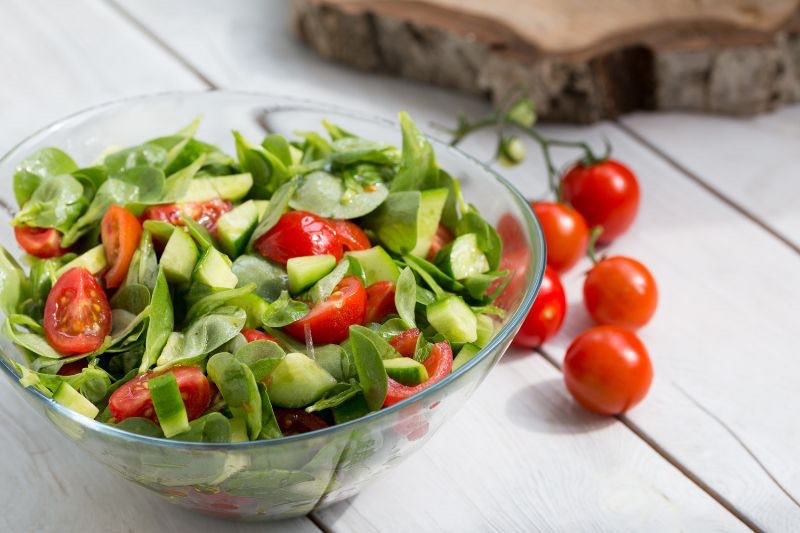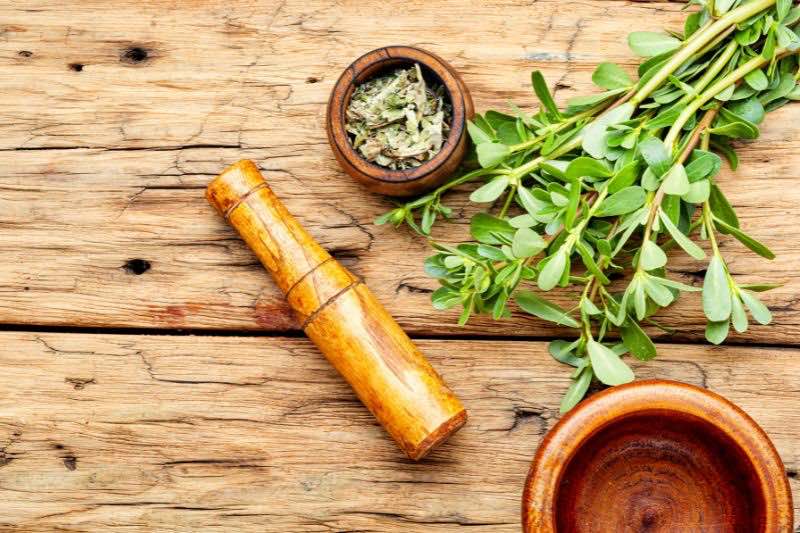Purslane (Portulaca oleracea) is a small edible annual plant, prized for its fleshy, crunchy leaves. The many benefits attributed to it are used as part of the famed Cretan or Mediterranean diet, a way of eating considered very healthy.
Easy to grow and low-maintenance, purslane is a creeping plant that quickly forms small cushions and has the advantage of tolerating drought well. Sometimes considered an adventive (“weed”), it can indeed self-seed in the garden and sometimes become invasive when happy. But since it is an edible plant, make the most of it in the kitchen!
Let’s therefore see how to harvest, store and use purslane raw or cooked in various recipes.

Which edible purslane varieties to choose?
Purslane is not toxic: all varieties are edible. Just be careful not to confuse it with prostrate spurge (Euphorbia prostrata), easily distinguished by the white latex that oozes when cut.
Among garden varieties, try for example:
- the green purslane, the most classic variety;
- the very bright golden purslane with large leaves;
- the winter purslane “Claytone de Cuba”, with slightly larger, spoon-shaped leaves (actually a cousin in the same family as purslane).
Wild purslane is naturally found in uncultivated places, along paths, but also on short grass meadows and in vegetable patches. It is particularly common in southern France and along the Atlantic coast. It is perfectly possible to harvest it in the wild. In that case, just be careful about the harvesting location: avoid roadsides, building sites, refuse tips or factory surroundings, where soils are more likely to be polluted.

When to harvest purslane?
Harvest will take place about 2 months after sowing, before summer flowering. It is the young fresh shoots (leaves and stems) that are most interesting gustatively. But purslane harvest can theoretically extend almost all year, from spring until first frosts, roughly February to November depending on region.
How to harvest and store purslane?
Using a clean pair of scissors, cut purslane stems leaving about 2 cm length (don’t cut flush), to allow regrowth. A single plant can be harvested two to three times a year, depending on development.
Choose leaves that are well green (or golden for the corresponding variety), fleshy and free from spots.
Purslane leaves and stems do not keep long. Use quickly after picking. It is however possible to keep them 2 to 3 days in the fridge, wrapped in a tea towel or absorbent paper.
Properties associated with purslane
Many benefits are attributed to purslane. It is said to be rich in:
- omega-3;
- iron;
- vitamins A, B, C;
- calcium;
- phosphorus;
- antioxidants.
Purslane is also rich in mucilages, a plant substance with thickening properties, appreciated for its emollient, anti-inflammatory and hydrating virtues.
Purslane in the kitchen: different raw or cooked uses
Purslane can be eaten in cold or hot recipes. Cooked, it will lose some of its properties, but this is an interesting solution for cooking older, slightly wilted leaves that are less attractive.
Purslane has a mild, delicate, slightly tangy flavour. It offers a fresh, slightly juicy but crunchy texture.
Before using, simply soak in clear water, optionally with a tablespoon of white vinegar. Drain, then remove excess water using a small salad spinner or by blotting the leaves in a clean cloth.
In salads
One of the main uses of purslane in cooking: it makes excellent mesclun salads (mix of shoots and leaves) bringing a crunchy texture. Its subtle flavour pairs with all garden leaves, even the stronger ones: rocket, lamb’s lettuce, curly Batavia lettuce, oak-leaf lettuce, chicory, young spinach shoots, etc. Add flavouring herbs such as mint, lemon balm, basil, coriander, chives, or shiso for a colourful touch.
Optionally, top with capers, sliced pickles, cheese cubes, sun-dried tomatoes, walnuts… This is a simple dish, adaptable to available ingredients and a chance to be creative!
For dressing this original salad, prepare a vinaigrette based on vegetable oil (olive or rapeseed, for example), mixed with a teaspoon of mustard or vinegar, plus a pinch of salt and pepper.
Purslane can also be incorporated without problem into other salads: tabbouleh, tomato salad or cucumber salad. Try it in a Buddha bowl, that cold vegetarian dish composed of small portions of each ingredient placed in a bowl.

As pesto
Purslane makes a good homemade pesto, as a substitute for basil. Chop finely with garlic, Parmesan, pine nuts, olive oil, salt and pepper. Perfect with pasta, of course, but also as a spread for starters.

As a sauce
Purslane also makes a very good sauce to drizzle over fish, prawns, light meats or plant proteins (tofu, seitan or textured soy). Simply chop into yoghurt or crème fraîche with lemon, a finely chopped shallot and tarragon for a fresh, tangy dressing.
Pickled in vinegar
Purslane stems and leaves can be prepared as a condiment, preserved in white vinegar like capers or pickles. Season with garlic, pink peppercorns, peppercorns, rosemary or dill.
Pan-fried
Purslane can replace spinach in many recipes. Quickly sautéed for a few minutes in olive oil or butter with a clove of garlic, it makes a good side dish. Note that, like spinach, purslane tends to lose volume when cooked.
In a soup
Thanks to the many mucilages it contains, purslane swells on contact with water and naturally thickens preparations. In vegetable soups, it is therefore perfect for adding texture. You can include it in a summer velouté of sun vegetables (courgettes, aubergine, peppers…), a velouté with late squashes in early spring or a potato and sorrel velouté.
In cold version, also try gazpacho with purslane, which will reduce slightly the amount of stale bread needed for thickening in this recipe.
Incorporated into various hot dishes
Also consider purslane to add texture and greenery to various dishes: omelettes, risottos, stuffings, quiches, gratins, samosas, etc.
It can also simply be finely chopped at the last minute over a dish to add a decorative touch and crunch.
If you have tried other purslane recipes, feel free to share them with us!
































Comments